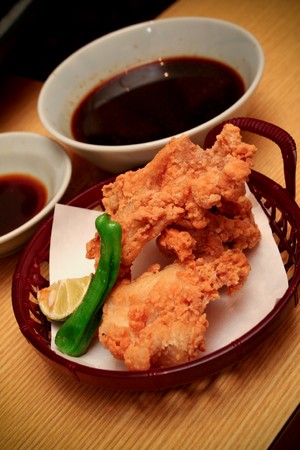Delicious Weird Eats

I will try basically anything a restaurant serves. I often meander into entrees that include popular ingredients like beef, chicken, fish, vegetables, lamb, et cetera. I will also try dishes that have ingredients that are foreign to most people’s palates (Escargot? Count me in. Cow intestines? Please?). Growing up in a Filipino household, I would encounter dishes made with ingredients that are, well, uncommon compared to typical American cuisine, i.e., pig’s blood, and I loved every morsel of it. However, there are people that might cringe at the thought of mixing their appetite with things that may go bump in the night. I say, “Don’t knock it until you’ve tried it.” These unfamiliar ingredients that many people dare not go near have been used since the conception of most European and Asian fare. In the hands of talented chefs, they are the center pieces of many fantastic dishes that can stimulate anyone’s culinary senses. Many of our restaurants feature dishes created with uncommon ingredients, and trust me, they are created by the skillful hands.
Owner and Executive Chef of Table 926 in Pacific Beach, Matt Richman, is no stranger to exposing guests’ taste buds to new and different flavor combinations. Constructing his entrées with in-season ingredients, Chef Richman blends Californian cuisine with Mediterranean and Latin American flavors. His Glazed Pork Cheeks with guajillo-tamarind glaze, braised greens and polenta is a perfect example. Pork cheek, also known as guanciale, is often unsmoked Italian bacon, similar to hog jowl used as seasoning in Southern soul food. However, Chef Richman has used this part of the pig to create a dish that touches base on his own culinary philosophy and offers a delicious dish that is tender and savory.
Located in Downtown La Jolla on Prospect Street, George's California Modern offers an a la carte dinner menu that boasts a wide range of exquisite selections that focus on California ingredients with a modern twist. Executive Chef and partner Trey Foshee showcases his culinary genius by taking traditional entrees and ‘turning them inside out’. He uses a part of the cow that many people wouldn’t dare to eat: the tongue. Chef Foshee’s Warm Beef Tongue is paired with grilled onions, avocado mousse, habanero, smoked garlic tomato vinaigrette and house pickles. Beef tongue is very high in fat, with almost 75% of its calories coming from it, and that is what makes it so delicious. The high fat content added with the taste of beef gives diners a fabulous mixer that ultimately makes a wonderfully savory main dish.
While Japanese restaurants may be a dime-a-dozen now, many manipulate diners into thinking what they serve is actually traditional Japanese cuisine. However, it’s generally accompanied by Western-style characteristics (Do you think the crunchy roll’s origin was from Japan? Yeah, I didn’t think so, either) masked behind low-grade ingredients. Very few establishments in San Diego are genuine Japanese cuisine. Guests at Robata Ya Oton, however, can engulf all their culinary senses in a traditional Japanese menu that exceeds the boundaries of teriyaki chicken and white rice. Head Chef Aiko Ishito has created a classic menu that features entrees like Shio Chanko and Miso Chanko—hot pot dishes that consist of a variety of vegetables, mushrooms, tofu, seafood, chicken and pork in a flavorful broth—and a full list of Yakimono, grilled entrees featuring common meats such as beef, chicken, and pork. In addition to the meats on the Yakimono list, Robata Ya Oton offers other protein choices that are a little bit, unusual by western diners' standards. Dishes like grilled chicken oysters, gizzards and hearts are only the tip of the iceberg. First, a chicken oyster isn’t what the syntax might lead people to believe (no, they’re not oysters filled with chicken, promise). Chicken oysters are two small, round pieces of dark meat on the back of poultry near the thigh, regarded as the most flavorful and tender part of the bird. Chicken gizzards are, on the other hand, less ambiguous than chicken oysters, but still an uncommon part of the chicken that many people do not eat. The gizzard is an organ found in the digestive tracts of animals such as birds, reptiles, certain gastropods and some fish. Gizzards are commonly served in the southeastern region of the United States and countries such as Haiti, Indonesia, Uganda, Cameroon, and Japan. They are usually deep fried and taste somewhat like liver, with a chewy consistency similar to the heart. This makes it an ideal part of the chicken for those who enjoy these unique flavors and textures. Chicken hearts need no explanation of location. The taste is comparable to the dark meat of the chicken and has a slight metallic aftertaste. For fans of the mineral taste of liver, the heart and gizzard are other options to try that have a slightly different consistencies, making the epicurean experience into the unknown that much more exciting.
As far as I’m concerned, food is food. Whether it’s a juicy, tender filet mignon or a juicy, tender beef tongue, they both can be made into a delicious entrée in the right hands. Of course we all have our likes and dislikes (I can’t stand chicken feet), but I would never know if I didn’t try it, at least once. I figure; I might as well find what all the fuss is about, considering people all over the world are eating these uncommon parts of livestock on a day-to-day basis. Who knows, maybe you will discover your new favorite treat. You'll never know until you take the chance.
Copyright TableAgent.com
© Restaurant Agent Inc.